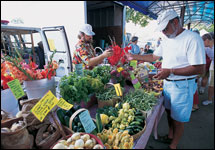MLUI / Articles from 1995 to 2012 / Farmers Markets Bloom With Shoppers Seeking Fresh Food
Farmers Markets Bloom With Shoppers Seeking Fresh Food
Direct sales outlets protect farmland, boost downtown districts
January 30, 2003 | By Patty Cantrell
Great Lakes Bulletin News Service
 | |
| Pat Owen | |
| Traverse City's downtown farmers market. |
All it takes is a Saturday morning at the bustling farmers market in downtown Ann Arbor to understand how significant the fresh food outlet is to both farm and city economics.
The market hosts 87 growers who sell everything from vine-ripe tomatoes and colorful flowers to homebaked bread and handcrafted bread boards. The market also is an economic outlet that keeps 3,212 acres of area farmland in agriculture, providing local residents not only with great views but also excellent water quality and wildlife protection.
In addition to higher farm incomes, Ann Arbor’s farmers market draws thousands of shoppers who spend their money at nearby stores and restaurants. These businesses keep up the local tax base and keep the downtown area alive and thriving.
“Our retail and restaurant tenants achieve higher sales due to their proximity to the farmers market,” says Robert Aldrich, vice-president of the MAV Development Company, which built the Market Place group of shops next to the farmers market. “These higher sales allow us to charge and maintain higher rental rates,” he adds.
Not Just College Towns
But you don’t have to have a downtown college crowd like Ann Arbor for farmers market success.
The farmers market in the south central, industrial Michigan city of Jackson has had a long waiting list of farmers eager to sell there ever since the market started 15 years ago in the middle of a recession. Some of the growers come from as far as Kalamazoo for the opportunity, says John Rasmussen, a consultant who helped both the Jackson and Ann Arbor markets get started. And if you don’t have a town center, you can use a farmers market to make one, says David Judge of Farmington, a drive-through remnant of a small town now surrounded by Detroit suburbs.
Mr. Judge is leading an effort to raise money for a pavilion to shelter and dress up an existing farmers market in Farmington. “We really need a way to attract and keep people there,” Mr. Judge says. Shoppers who come for farmers markets are known to “stick around” and visit other businesses while they enjoy the sense of community that the bustle around markets can create.
Room to Grow
Other Michigan communities, such as Kalamazoo and Leelanau County, are stepping out to take advantage of the economic development and farmland protection value that farmers markets provide.
But Michigan has room for many more farmers markets than its current total of 65. The state has a large consumer population and a wide range of agriculture products. Yet Midwest neighbors, Illinois and Wisconsin, host more than twice as many farmers markets.
Contacts: Susan Smalley, Michigan State University Extension, 517-432-0049, smalley@msue.msu.edu; John Rasmussen, 800-414-9160, publicmkt@aol.com; United States Department of Agriculture, www.ams.usda.gov/farmersmarkets





